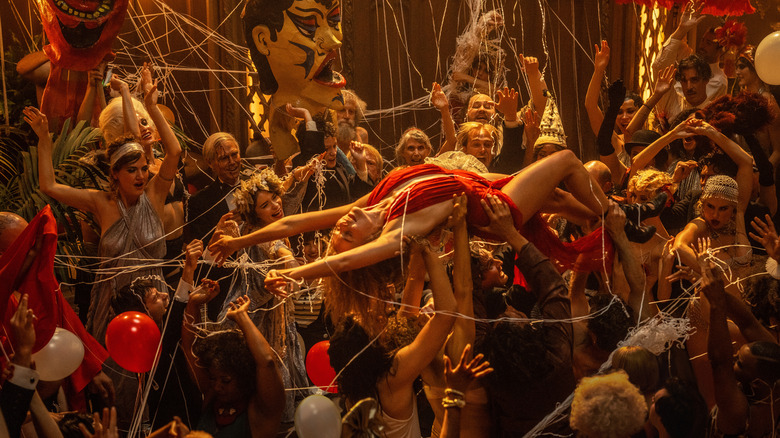Babylon Star Jovan Adepo On Shooting The Film's Wild Party Scenes - Exclusive
One of the signature elements of writer-director Damien Chazelle's new movie, "Babylon," is the string of Hollywood parties that punctuate the movie at various points. Set in the roaring '20s at the height of the movie industry's silent era, "Babylon" depicts a business that was yet to fall under both corporate ownership and the enforced morality of things like the Hays Production Code. The Hollywood we see in "Babylon" is one where both creativity and hedonism run rampant, sex and drugs are abundant and easily accessible, and one person's debauchery is another's transcendence.
Nowhere is this more evident than in the film's 20-minute opening sequence, which takes place at an over-the-top bacchanalian fest thrown by Kinoscope Pictures head Don Wallach (Jeff Garlin). It's at this ridiculously excessive soiree — which features a live elephant, people freely copulating in public, and piles of just about any substance one would care to intake — that we meet the film's central characters.
Among those are Nellie LaRoy (Margot Robbie), an aspiring starlet from New Jersey; Jack Conrad (Brad Pitt), a leading man whose best days on and off the screen may be behind him; Manny Torres (Diego Calva), who works odd jobs on the fringes of the business as he looks for his big break; and Sidney Palmer (Jovan Adepo), a jazz trumpet player who's hired to play at the parties but suddenly becomes a movie star as the sound era in Hollywood begins.
As for the party scenes themselves, Adepo tells Looper that Damien Chazelle did everything he could to make the energy and atmosphere seem as real as possible for the cast and crew. "People were always finding that energy and getting amped up," Adepo recalls in our exclusive interview. "And he would come in and get everybody hyped."
Those Babylon party scenes were as real as possible
When one watches "Babylon," especially the party scenes, it's immediately evident how Damien Chazelle's direction, combined with the cinematography, the editing, the production design, and the score, create a truly immersive and often overwhelming snapshot of what a decadent shindig like this might have looked like back in 1920s Hollywood.
Jovan Adepo says that a lot of what you saw onscreen (minus the sex and drug-taking) was happening on the floor. "The editors, of course, did a brilliant job capturing all of the partying, but it was definitely what you saw in [the] film," he remarks. "I don't think there's a way that you can fake that because it's not like we had CG background people. We had all practical, real background artists who were brilliant, and that kind of energy was exactly how it appears on screen."
Adepo adds that the opening party scene alone took around 12 days to film, and during that time, Chazelle took steps to make sure that the cast, the dancers, and all the background artists and cast members kept their energy level up at "full tilt."
"There were speakers in the theater that we were performing in, and in between takes, he would always just blast music," recalls the actor. "After a really long take or a couple of hours in a certain camera angle or whatever, as they're changing setups and stuff, he would just blast music like it was a fricking nightclub. So people were always finding that energy and getting amped up, and he would come in and get everybody hyped. It was a really cool atmosphere and a great way for him to kind of control the energy in the room and get the takes that he needed."
"Babylon" is in theaters now.

